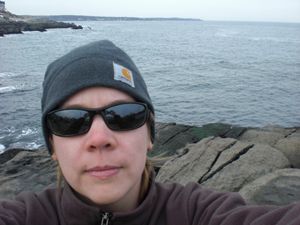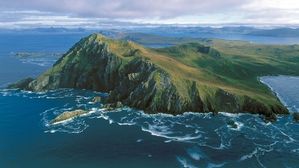Ruta 40
•November 28, 2009 •
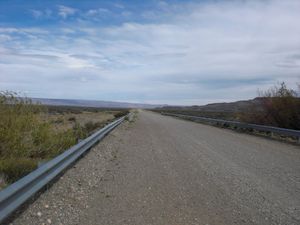
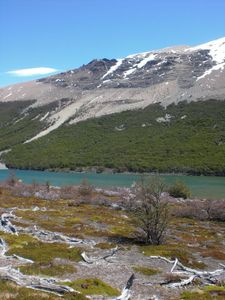
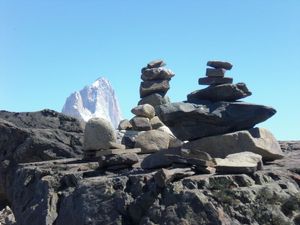
It’s a big desert– or if not a desert, arid plains, and steppe-land, and thousands of kilometers of gray brush, sand, and fenceline. We ride through so slowly, on this behemoth bus with a cracked windshield and leaky hubs. Come to a halt at every cattle-guard, for every imperfection in this gravel road. Ruta 40 is in constant detour for paving, a national project.
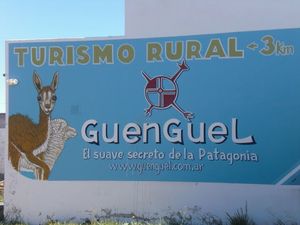
It gives a person a sense of scope, to drive for two days through this place. We get away from the tourist traps and the beaten path, pass through towns that see just 2 buses a day. All dirt roads, and high schoolers walking home in uniforms. Here, there is no myth of Patagonia, only people trying to make a life in this dry land, Santa Cruz, Chubut, up towards Rio Negro. Off the Cordillera.
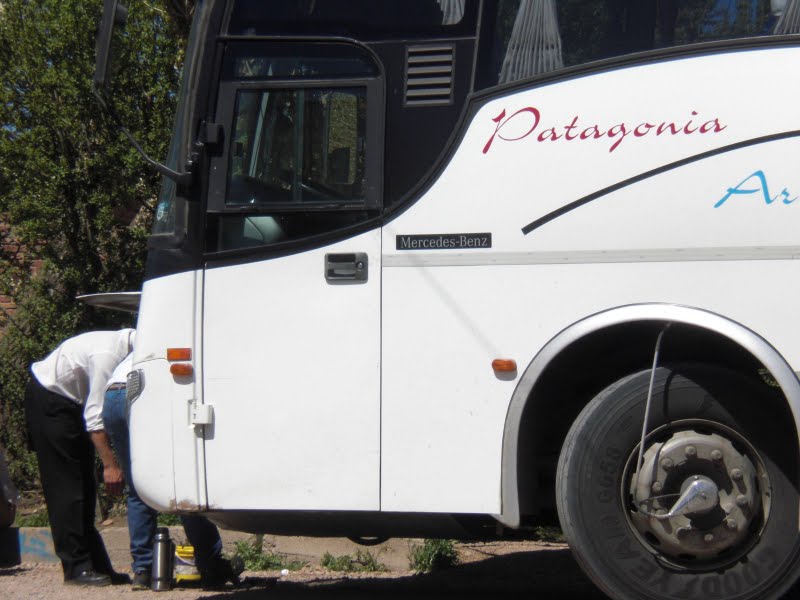
The drivers screeches to a dusty halt to jump out and run down an armadillo. He brings it back to the bus so the curious can take pictures. I never knew their undersides were so fuzzy. He tries to dig to escape, and wheels in air, and then when released runs in circles around our legs until he finds an exit and takes off in a cloud of dust. The next abrupt stop is so the driver can cut the tail off a newly dead fox. This is Thanksgiving Day, for me.
The coolant begins to leak. We limp into Gobernor Castro, and the divers dirty their shirts fixing the punctured line. I drink OJ on a curb and watch a policeman help some schoolkids across the road. One says “hi” to me, how precocious! The others say “hola” and file past.
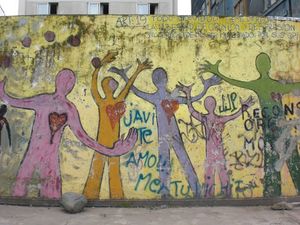
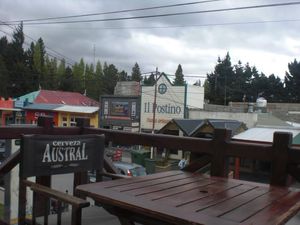
More bumpy hours. After 26 hours of desert, we ascend a pass and cross into a valley. Suddenly there’s the scent of water in the air. And green things everywhere, and snow-capped mountains rising abruptly. It’s all green and blue. Lakes, pines, lenga, alpenglow. El Bolson and Baricloche seem like oases, alpine Edens after desert.
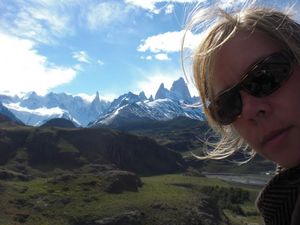
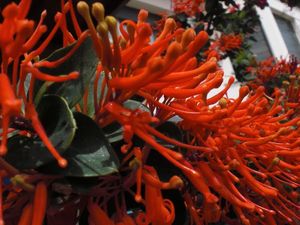
—
Los Glaciares
November 28, 2009
Sunshine, pink flamingos. We explore an arroyo, and drink mate, drink mate in the sun. The hostel is on a hill. The wind blows the broken window open sometimes. The view is blue sky, green lake, white mountains. Brown earth. Orange and yellow sunsets, and the Southern Cross.
The hiking is simply epic in Los Glaciares. The clouds blow off Fitzroy the afternoon we arrive, and the mountains stay clear for two days. We go to Loma, and are rewarded with insane views of Cerro Torre, Poincenot and Fitzroy simply shining against a deep blue sky. The wind is moderate, quite a change from my last swing through, and we eat crackers and salami for lunch looking down on Glacier Grande.
The next day I actually get sunburnt, hiking to Poincenot, Madre y Hija and down. I know its happening, but decide some things are worth it. This is the first objective warmth I have felt in Patagonia, and my body drinks it up like this is the spring after winter although summer was just two months ago for me. And winter is just a week away.
—
Ushuaia
November 21, 2009
Cape Horn was the turning point of the trip– in space and time. What a bittersweet moment, to have reached my austral goal and to realize that it’s time to go back north, and that my trip is halfway over. But even north here is still pretty south.
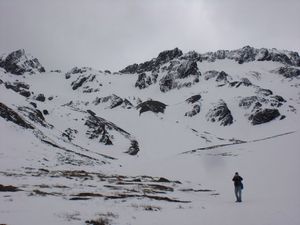
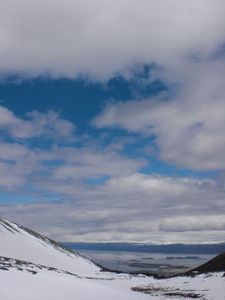
I love Tierra del Fuego, another week in Ushuaia surrounded by the blue Beagle Channel, snowy Andes and these crumbly lenga forests. We hike Martial Glacier, and decide that finding the glacier is just an excuse for the view of water, Navarino and two-toned blue sky. We visit the Maritime, Prison and Art Museums. Walking through that old presidio gives me the chills, and we take the convict train to the National Park. We eat centolla, bife, cordero, and queso patagonico, and of course sample the malbecs and the artisan brews. There are protests outside a Municipal building, men are beating drums and a warming fire is lit in the middle of the street. In my clunky Spanish I manage to ask someone what’s happening, and tells me they are demonstrations of the unemployed— and I understand!
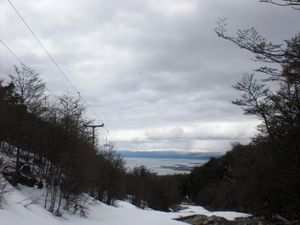
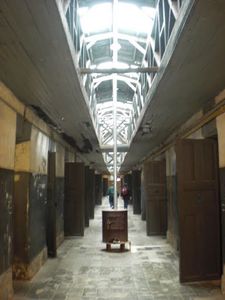
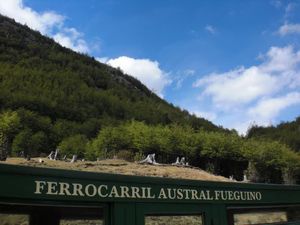
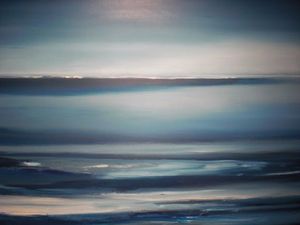
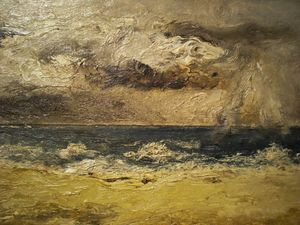
The day we leave Ushuaia is a sad one. It began to feel like home to me. But we touch down in Calafate and the sun is out, and that’s good too.
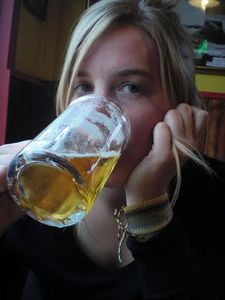
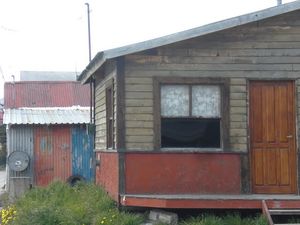
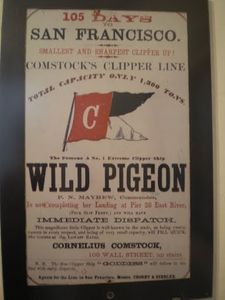
—
Rounding Cape Horn
November 15, 2009
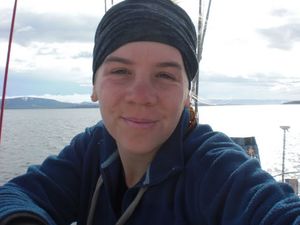
09.11.09: The Santa Maria Australis departs Ushuaia carrying 8 souls. Paperwork at the Prefectera and then sailing to Puerto Williams, Chile, in calm waters.
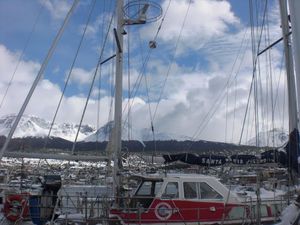
10.11.09: More paperwork in Chile. Its a beautiful harbor, with the derelict wreck of the Macalvi Yacht Club closed for rebuilding. I am struck by how black and inky the water is when its not blown by the wind or broken by our wake. I saw penguin, dolphin and albatross, and learned to steer the boat by degrees and by sight, through shallow channels off Isla Navarino. Its like controlling a car skidding on ice, a slow and subtle process nudging the rudder and waiting for the result. Being on a boat is not like the camping I’m used to. For one, it’s heated in the saloon. And we are self-contained, with our beds and food and heat and water all aboard. My small berth has a pillow and sheets and a blanket instead of a sleeping bag. We have wine and beer because we don’t have to carry it. Oh, and a hot shower– what luxury!
Anchored after high winds at Isla Lennox, a beautiful cove with just a coast guard station, and one fishing vessel. It’s king crab season, centolla, and informal buoys appear on the water out of nowhere.
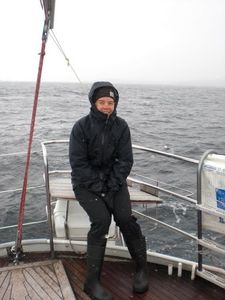
11.11.09: Rocking back and forth off Lennox this morning. We head due SSE towards the Cape Horn Archipelago, the Wollaston Islands. It’s calm today, and after crossing the Nassau, the waters are still and unbroken. I think about the surface tension, how the water looks like the air is holding it down, how the water holds itself together. We travel the Washington Channel and see a fur seal colony, they dive in this cold water and follow the yacht, peering at us. Even on the rocks they are fairly agile, climbing higher than I though possible. These islands are beautiful and look like what they are: the sunken summit of the Andes. We anchor at Isla Hermit, tie off in a shallow bay at three points. Take the Zodiac to shore and hike the nearest mirador. The Cape is just to the south– I can’t believe it, after all these months and miles my goal is within sight! I am truly far south now, I can see the end of not just the civilized world, but indeed the inhabited world. There is only the Drake Passage south— then Antarctica and the pole. This is the end of the continent, the end of land, of walkable places, of America, bigger than I ever thought it was. And I have been to the top and the bottom, and a few of its edges.
Such gratitude! I realize even with all the trials and moderate misery of my circumstances back home, my life is exactly what I wanted it to be. I am so far away! This is an astonishing adventure, pull down your atlas and look for Tierra del Fuego, and Cape Horn. I AM HERE! I tell the wind, “thank you” because I don’t how else to send the message, or to whom exactly, there are so many who deserve to hear it. Trust the wind to take the words there.
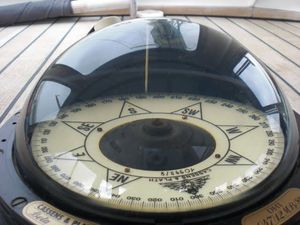
12.11.09: I oversleep,dreaming of giant red snakes taking over the world. J wakes me at eight for the remains of breakfast, and the wind is up, contrary to the Armada forecast. But we can go, so we do.
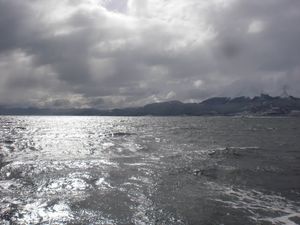
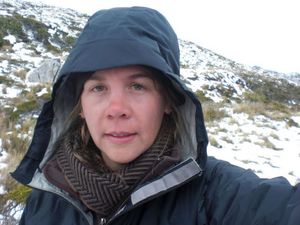
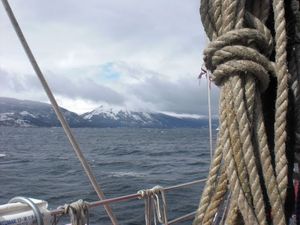
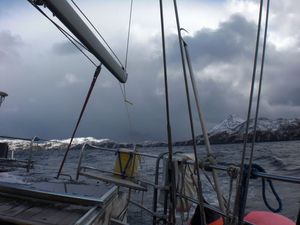
Once we hit open water south of Isla Hermit it gets very rough very fast. The sails are out but not catching steady wind, we plow through waves and spray comes flying up over port. A trough, and the mainsail boom goes slack and swings, and snaps back starboard hard but the ropes and pulleys hold, and several Germans and a Brit come flying across the cockpit. J tells me and P to wind in the jib and something snaps. A rope out of its wench. The boat is nearly sideways, crashing in the waves, the jib is almost totally loose. Alarms are going off in the cockpit. Spray, water, angles, chaos. But J and P get the jib in, and when the boat rights itself somewhat the alarms quiet, and we continue on, still crashing over this ocean. It changes from snow to sun in minutes, and after one squall clears we see the Horn to port, and when we are due south we pop champagne into the mainsail while roped onto deck with lifelines, and continue east into the quieter waters of the Atlantic.
On land at Cape Horn, seeing the albatross monument. This one affects me particularly. Sailing this way, exposed to the water, the winds and the cold. And peering over the short deck of this boat into unreflecting water. How cold I get out here on the water, in that wind! And the albatross, when it lifts off the water seems to just rise.
13.11.09: Spent the night anchored off Isla Herschel. At breakfast J says the government has made land concessions to a tourist company and soon there will be a pier and hotel here for the big cruise ships. What used to be a nature preserve, and so remote. I get thinking about distance. Cape Horn is only 170K from Ushuaia. Two hours by car on a straight paved road. But there is no road and no straight lines. So it takes days by boat, at seven knots. How relative distance is! I noticed hiking the common way to measure distance here in Patagonia is with time. (How far from point A to point B? 4 hours. But how FAR?) Like space and time are one. Which refutes all my theories about finitude.
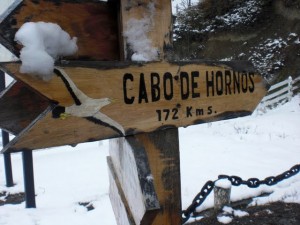
The islands here are life buoys. They flatten out the waters and break the wind. On one or two of the islands we have seen the remains of Chilean Army outposts, now totally abandoned and rotting under their rusted tin roofs. But it makes me wonder how a person could live here, or if. There is some water, many birds and fish, but finite trees for fuel. And so cold!
And now that we are heading north again, we finally catch a good steady wind. The genoa and mainsail out all day, the ship lists starboard and flys over the Nassau. We slam over the waves, spray splashing sometimes over the cockpit. I can feel the velocity, the power of the pull and sails. I love this part: the quiet, the tilt, this hard wind.
14.11.09: Safe Harbor in Puerto Williams after a long sail. It’s time for me to leave the boat to the rest of her journey to the Darwins. So I head out to Williams, a town of muddy streets, stray dogs, and views. I share a last mate with J and P, and they motor back to the yacht, and when I look again the boat is gone, like a dream. Supposedly there is a ferry crossing to Ushuaia booked for me by the ship’s owner- he and I are trying to confirm this. But all the callboxes are closed since it’s Saturday. So we begin looking for Francisco, and his restaurant is closed, and start asking where he is and no one knows. Then we see the immigration officer who has stamped me in and out of Chile, at this point, several times. He tells us forget about Francisco, we need to talk to Pancho. So up to a little customs office where there’s a phone, but Pancho is not answering. So instead a coffee break at W’s house. His wife says todo bueno, I am going back to Ushuaia. This is getting things done, Chilean style. In some ways I don’t mind, its a social process, and reminds me how helpful people want to be.
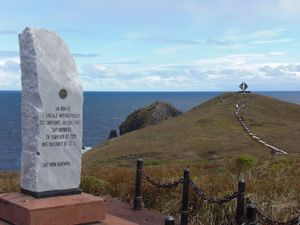
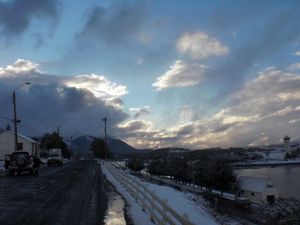
—
Tierra del Fuego
October 8, 2009
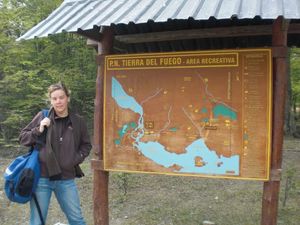
Only in Patagonia would your mountain guide tell you it’s going to be an easy day, and then take you on a 28K hike. But the French Valley of Torres del Paine was worth seeing, as was Ascencio. We arrived to Chile after a long day on the bus, an easy border crossing, then pisco sours and fried meat. The Paine Mastiff is beautiful, it’s two-tones are unreal in clouds and in sun. The weather held, and on day two we climbed to a mirador on a glacial lake just under the Torres, and the sun came out, and a perfect blue Patagonia sky. Day three, I saw an avalanche run down the French Glacier. After days of hearing avalanches and rockslides it was fantastic to see the plume and puff of powder.
Onto Puerto Natales, a beautifully crummy little port town with its buildings painted every possible color. I got just a taste of what the Chilean Fjords must be like, looking out on that blue water and mountainscape.
Back to Argentina, and onto Tierra del Fuego. Crossing the Strait of Magellan I saw a Magellanic dolphin for just an instant, And then, FireLand, the End of the World! Sheep ranches everywhere, crumbling fenceline that reminds me sometimes of the North American West. It is an extreme place, becoming more so the further south I travel. Nights are longer, the weather changes even faster. Continued through broken lenga forests covered in lichens to Estancia Las Hijas.where and a lamb parilla, over an open fire. So simple, just hospitality, what a way to live.
Tierra del Fugeo is a land of peat bogs, swamps, vista, lichen, and crumble. It’s haunting and peaceful, inhabitated by beaver and bird. It’s easy to feel lonely here, even when other people are around. Coloane’s stories are beginning to come to life for me in an entirely new way. In Boston I struggled to understand his often bleak views of nature, but here, I sense its motives. This land is dramatic, derelict, huge and empty. Some moments it seems the best a person can hope for is a companion and hot mate. But then I touch the bark of the nothofagus. It feels dry, a clear sensation. There’s something magic here, surely.
I’m also beginning to understand the notion of pilgrimage in a new way. I’ve met many travelers, all here for this earth- some wait their whole lives for Patagonia. And it’s myth has not disappointed. I can think of nowhere I know to compare. There are no words to describe the grandeur, the scope, the scape, the scale– which is why for now I have to let the pictures do the work for me!
Tomorrow I sail aboard the Santa Maria Australis, we’ll see if we can make the Cape.
—
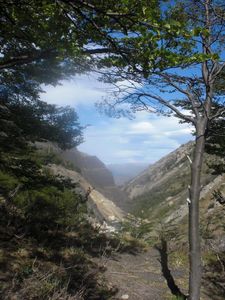
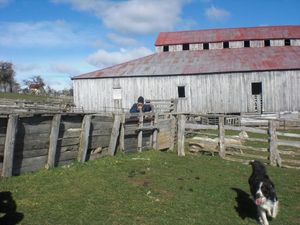
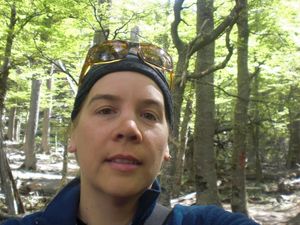
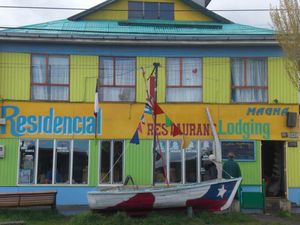
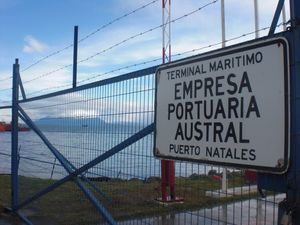
—
Steppe
•October 30, 2009 •
It took me about five days to fall in love with this place.
Today we saw an older Patagonia, more original to history. On a dirt backroads to Los Glaciares we bump over the steppe: guanacos, choyique, condors, eagles, flamingos, hares! And vistas in every direction. At an old estancia (now bar) there’s a barrel stove giving off heat and guachos smoking meat. The horses’ tails are bobbed, and the guachos wave at the bus full of us tourists. Its so peaceful. Just wind in the grasses and brush, sleeping sheep, horizon. When a lamb wanders inside the barista scoops her up and deposits her back onto the porch.
Perito Moreno is one of only three glaciers in the world that is actually growing. It cracks constantly, and once I managed to see a cascade of ice calving into the green waters. It’s huge, especially from the water, although its only a quarter of the size of Once and Upsala.
Tomorrow we leave to Chile for Torres de Paine and four more days of hiking— next post from Puerto Natales!

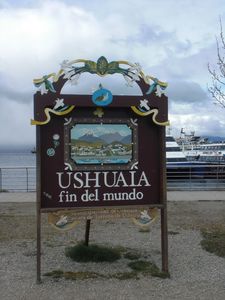
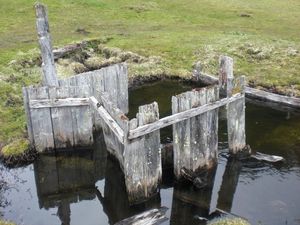
—
Calfate
•October 24, 2009 •
Enjoying an afternoon in Calafate- after the heat and chaos of BA, this place is is a welcome change. And I’m finally, officially in Patagonia! Here, it’s vast, arid and brown like the North American West, but has the frontier feel of Alaska. It’s beautifully derelict. A light snow, and enough space to see horizons. Dogs seem as common as people on the streets downtown, sleeping on the road, or chasing cars.
Tomorrow, it’s off to Fitzroy for some backpacking.
—
So far, so good! I’ll be heading to Patagonia the third week of October, bypassing Buenos Aires for Calafate. I’ll be starting the trip with some back-country hiking in Los Glaciares and Torres del Paine, before heading further south to Tierra del Fuego. There, I will be sailing what Chilean writer Francisco Coloane calls the “strange and lost waters at the edge of the world”– hopefully ’round Cape Horn. Bariloche and the pampas are on the itinerary too! Coloane describes a connection when one looks at “nature itself, as if asking [it] something, and [it]… return[s] the look to us inexpressively; but a current is established, something happens in our minds, a light goes on, and we discover what we were looking for, even though it may not be anything more than the peace from our own uneasiness.” I hope to find that in the austral landscape.
—
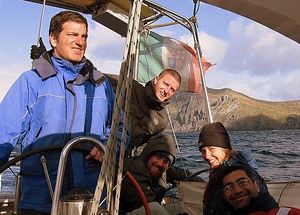
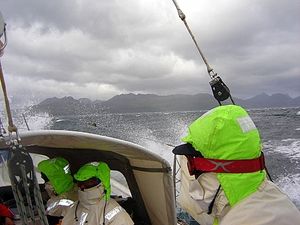
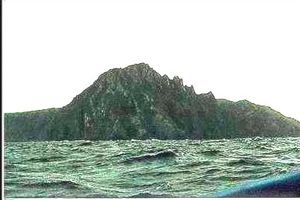
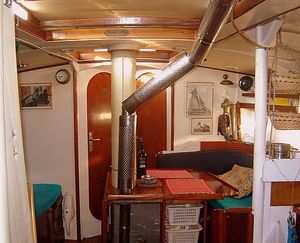
—
An Excerpt
14 September, 2009
An excerpt from WH Hudson’s “Idle Days in Patagonia” which seems to suit my September mood, and anticipates October, and reminds me of movement over landscape.
“If things had gone well with me, if I had spent my twelve months on the Rio Negro, as I had meant to do, watching and listening to the birds of that district, these desultory chapters, which might be described as a record of what I did not do, would never have been written… seeing one class of objects too well would have made all others look distant, obscure. Lying helpless on my back… with the white-washed walls of my room for landscape and horizon, and a score or two of buzzing house-flies, perpetually engaged in their intricate airy dance, for only company, I was forced to think on a great variety of subjects, and to occupy my mind with other problems than that of migration. These other problems, too, were in many ways like the flies that shared my apartment, and yet always remained strangers to me, as I to them, since between their minds and mine a great gulf was fixed. Small unpainful riddles of the earth; flitting, sylph-like things, that began life as abstractions, and developed, like imago from maggot, into entities: I always flitted among them, as they performed their mazy dance…
I caught nothing, and found out nothing…
Our waking life is sometimes like a dream, which proceeds logically enough until the stimulus of some new sensation, from without or within, throws it into temporary confusion, or suspends its action; after which it goes again, but with fresh characters, passions, and motives, and a changed argument.”
—
Next fall I’ll be flying south to experience the mythic wilderness of Patagonia by land and sea. I want to experience the landscape bodily, for three months, by hiking the backcountry of Los Glaciares and Torres del Paine National Parks, rounding Cape Horn clinging to a 40-foot yacht, and exploring dynamic, austere Tierra del Fugeo.
Maia Rauschenberg
